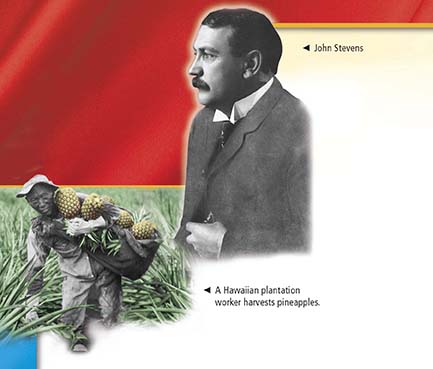SECTION 1: The Roots of Imperialism

WITNESS HISTORY  AUDIO
AUDIO
America Eyes Hawaii
“The Hawaiian pear is now fully ripe and this is the golden hour for the United States to pluck it.” John Stevens, U.S. minister to Hawaii, was not talking about fruit when he sent this note to the Secretary of State in 1893. He was talking about the United States taking over the Hawaiian Islands—along with their rich fields of sugar cane and pineapples. And Stevens did more than just talk. He ordered the United States Marines to aid in a revolt against the queen of Hawaii.
Five years later, the Senate finally agreed to annex Hawaii. The “Hawaiian pear” became part of the United States.
Objectives
- Identify the key factors that prodded America to expand.
- Explain how the United States took its first steps toward increased global power.
- Summarize the chain of events leading up to the U.S. annexation of Hawaii.
Terms and People
- imperialism
- extractive economy
- Alfred T. Mahan
- Social Darwinism
- Frederick J. Turner
- Matthew Perry
- Queen Liliuokalani
NoteTaking
Reading Skill: Identify Main Ideas As you read, fill in a concept web like the one below with the key events that marked America’s first steps toward world power.

Why It Matters For most of its early history, America played a small role in world affairs. But in the late 1800s, this began to change. With leading spokesmen calling for the United States to join the ranks of the world’s major powers, the United States began to acquire influence and territories outside its continental borders. The United States was abandoning isolationism and emerging as a new power on the global stage. Section Focus Question: How and why did the United States take a more active role in world affairs?
The Causes of Imperialism
During the Age of Imperialism, from the mid-1800s through the early 1900s, powerful nations engaged in a mad dash to extend their influence across much of the world. European nations added to colonies they had established during the Age of Exploration by acquiring new colonies in Africa and Asia. Following European success, Japan and the United States also began to consider the benefits of imperialism, the policy by which strong nations extend their political, military, and economic control over weaker territories.
Imperialists Seek Economic Benefits
One reason for the rush to grab colonies was the desire for raw materials and natural resources. This was especially true for European nations and Japan. They sought colonies to provide tea, rubber, iron, petroleum, and other materials for their industries at home. These colonial economies were examples of extractive economies. The imperial country extracted, or removed, raw materials from the colony and




